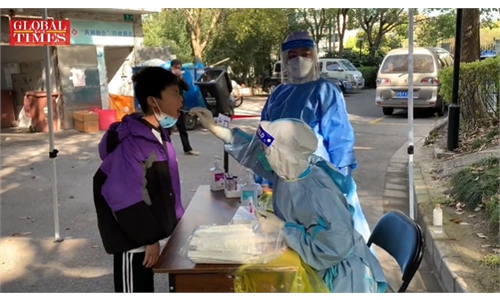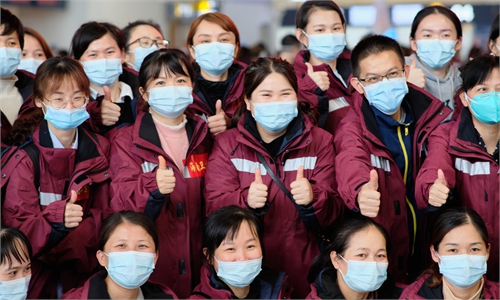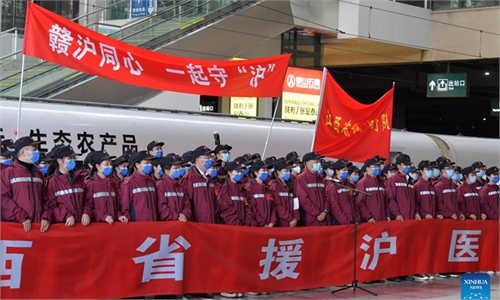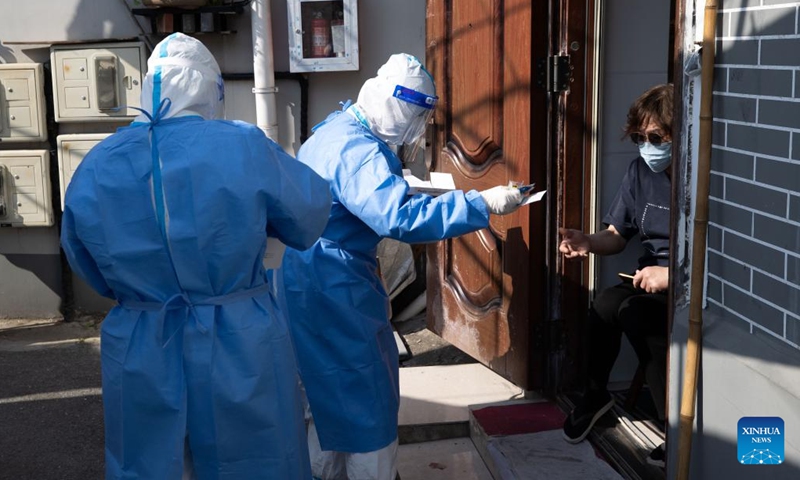
A medical worker guides a resident to do antigen home-testing in Shanghai, east China, April 3, 2022. Shanghai launched citywide antigen testing on Sunday and will conduct nucleic acid testing on Monday amid efforts to contain the recent resurgence of COVID-19 cases in the metropolis, according to local authorities. Photo: Xinhua
Shanghai, the city of 25 million people, had all residents take a nucleic acid test on Monday, the largest exercise of its kind in any city in China and the world, as the city fights off one of the severest waves of COVID-19 in the country.
The city has completed "mission impossible" of sampling as of around 7 pm, ahead of schedule, according to city health authorities, with the help of more than 38,000 health workers from all around the country.
The aim of this nucleic acid testing in Shanghai is to help recover the city's dynamic zero-COVID state, experts told the Global Times. The results of this nucleic acid test will reflect the effectiveness of the precautionary measures taken in Shanghai over the past week or two and determine what measures the city will take in the future, they said.
Experts and residents also believe Shanghai's situation is completely different from Wuhan two years ago, recognizing apparently improved diagnostic capacity and efficiency during the current wave, as well as more diversified, pragmatic and targeted treatment methods. Despite some twists and turns during the course as the financial hub is exploring to strike a balance between COVID-19 control and economic growth, the city could never been more resolute than ever and will emerge more experienced in racing against the highly contagious and more concealed Omicron variant, analysts said.
Make 'impossible mission' possible
The world-record testing target of 25 million started early in the morning.
A doctor surnamed Jiang from Songjiang district told the Global Times on Monday that she and her colleagues set off at 3:30 am this morning to take nucleic acid samples at various communities. "Over the past week, each of our colleagues usually need to take samples for around 2,000 people in the morning and 5,000 a day," she said.
Before Monday's mass testing, the city had conducted a citywide antigen testing on Sunday.
"We were told to do an antigen test on Sunday. If the result is negative, you can go downstairs to do the nucleic acid test on Monday. If the result is positive, you need to stay at home waiting for medical personnel to come and take sample," a resident surnamed Wu in Xuhui district told the Global Times on Sunday.
The measures were aimed at eliminating potential risks, cutting off the chain of transmission, curbing the spread of the virus, and achieving dynamic zero-COVID as soon as possible, health officials said.
At 7 pm, the city's health authorities released a statement saying that Shanghai had basically completed sampling throughout the city, which will be soon followed by testing, review and transfer of personnel.
Until the test results and subsequent control measures are announced, Shanghai residents are asked to remain at home unless seeking urgent medical care.
On Monday, Chinese Vice Premier Sun Chunlan inspected nucleic acid testing sites, sealed residential areas, centralized quarantine sites and the municipal big data center, stressing the need to take a more resolute attitude and more rigorous action to achieve the goal of "zero-COVID" within the general population in the shortest possible time.
Shanghai on Monday reported 425 confirmed and 8,581 asymptomatic domestically transmitted cases, the highest daily increases since the latest outbreak, bringing the total number of COVID-19 infections in the city to over 60,000.
Nationwide aid
At least 38,000 medical workers from across China have been deployed to aid Shanghai as of Monday in the fight against the Omicron variant, the largest number of nationwide medical aid since Wuhan in early 2020.
A total of 15 province-level regions have sent medical teams to help Shanghai to combat the city's worst outbreak since 2020, according to Chinese media reports. Most of the medical staff that have arrived in Shanghai will help with the mass nucleic acid testing, while others will help ease the burden on staff at makeshift hospitals.
More than 36,000 medical staff are from regions including East China's Jiangsu, Zhejiang, Anhui, Jiangxi, and Shandong provinces, South China's Guangdong and Hainan provinces, Central China's Henan, Hunan and Hubei provinces, Northwest China's Shaanxi Province, and North China's Tianjin and Beijing. Jiangsu sent the biggest medical team of around 13,000 medical staff, followed by Zhejiang with 8,700.
In addition, China's military authorities on Sunday dispatched more than 2,000 medical staff to Shanghai, according to the Chinese People's Liberation Army Daily. Medical staff were drawn from seven medical units affiliated with the army, navy and joint logistics support force. A Chinese Air Force heavy transport Y-20 aircraft was parked at an airport in Shanghai early Monday morning, according to a picture circulating on the internet. The Y-20 military aircraft had played an import role in delivering aid to help Wuhan fight the COVID-19 outbreak in early 2020.
PLA Western Theater Command Air Force posted photos of China's heavy transport Y-20 aircraft on Sina Weibo on Monday night, confirming its participation in the epidemic containment battle in Shanghai and encouraging the Chinese people to claim victory in the fight united as one.
In early 2020, more than 42,000 medical personnel from across China were deployed to Wuhan to aid local medical staff to treat patients and contain the spread of the virus.
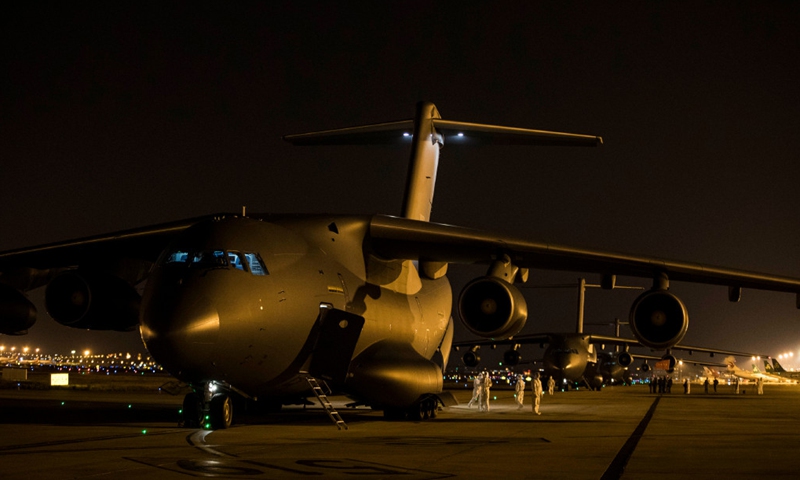
China's heavy transport Y-20 aircraft Photo: Sina Weibo account of PLA Western Theater Command Air Force
Next steps
The results of Monday's nucleic acid test will reflect the effectiveness of the precautionary measures taken in Shanghai over the past week or two and determine what measures the city will take next, experts told the Global Times.
At this point it is not yet clear to tell if the inflection point has occurred, Wang Guangfa, a Beijing-based respiratory expert, told the Global Times on Monday. "But if Shanghai's epidemic prevention measures prove to be effective, then there will be a significant turnaround in the epidemic generally after seven days, and a significant drop in cases after 14 days."
Wang noted that if new infections reported in Shanghai over the past few days were found in the population already under quarantine, then it could indicate that the control measures have had an effect.
An immunology expert told the Global Times on condition of anonymity that the biggest problem Shanghai is currently facing is that it is unclear how large a population in the city has been infected, and that this problem can be solved by Monday's testing.
The experts noted that the next step in Shanghai's epidemic prevention direction is still to learn from experience and decisively control the transmission route.
"At the same time, we also need to pay attention to the treatment of patients, measures for containment and control, whether widespread nucleic acid testing is necessary afterwards, etc.," the immunologist said. "It may take some time for Shanghai to see the real results.
As to whether Chinese cities will consider the possibility of having asymptomatic and mildly ill patients undergo home isolation in the short term, Wang said the most areas are not in a position to adopt such a policy.
"Most Chinese people, especially in cities, live in apartment buildings, and it's hard to administer proper home isolation. If they stay at home, then the possibility of causing more people to become infected is high."
Experts also pointed out that the situation in Shanghai has changed a lot from Wuhan two years ago, recognizing apparently improved diagnostic capacity and efficiency in this wave in Shanghai, as well as more diversified, pragmatic and targeted treatment methods.
The severity of the disease is much lower than it was, with vaccination rates over 80 percent, even though the infectivity of the current strain is at its highest, Zhuang Shilihe, a Guangzhou-based medical expert told the Global Times.
There has not yet been a severe case in Shanghai, which was also believed to be one of the most obvious improvement in comparison with outbreaks in Wuhan.
Special attention
In response to recent report that some patients with special conditions have not been properly accommodated for, the Shanghai Municipal Health Commission has issued notices emphasizing the focus on children, pregnant women, the elderly and other vulnerable groups.
Regarding the situation of children in isolation, Wu Qianyu, an inspector from Shanghai Municipal Health Commission explained at the news conference on Monday that according to law, infected people must be isolated from non-infected people.
"For the infected children, if their parents are also infected, they can stay with the children in the children's area to keep them company and receive treatment together," Wu said at a news conference on Monday morning.
For the patients aged under seven, if the family members are not infected, the infected children will be treated at the public health center. For older children and adolescents, they will be treated mainly in centralized isolation sites with professional pediatric medical teams to ensure that the children receive standardized and professional treatment and care, Wu said.
According to an official release from Shanghai, a rumor previously circulating on the internet that a mother committed suicide because she could not stay with her 2-year-old child was confirmed to be fabricated information. The mother, surnamed Zhu, has now been granted access to the isolation site to accompany her child.
Observers noted that misinformation surrounding the flare-up in Shanghai has become something that residents needed to fight against beside the epidemic.
At Monday's conference, Zhang Yahong, an official from the Shanghai Municipal Public Security Bureau, urged residents not to post or forward unverified information, as such acts violate local laws and regulations, and also affect the normal epidemic prevention order.
